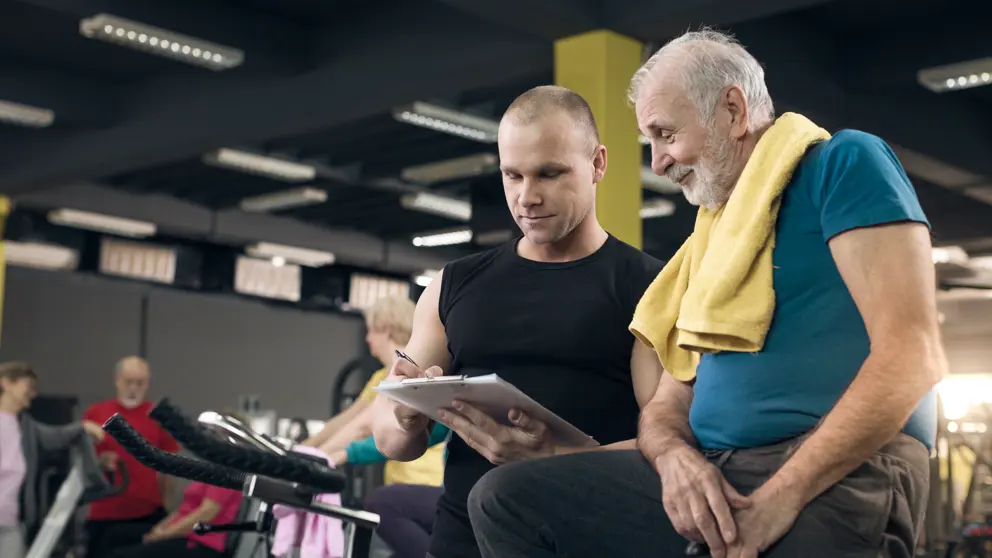I’ve been an avid exerciser since I was 15 years old (before that I watched more TV and drank more pop than anyone should in their entire lifetime). Being active is a key part of my life. It’s my morning coffee, gets me outside and meeting people, and it makes me feel good.
Then I was diagnosed with heart disease.
When I saw my cardiologist for the first time about my irregular heartbeats, he told me to stop my swimming in particular, until we figured things out. He was worried I would have a cardiac arrest (cardiopulmonary arrest) in the pool. This literally put the fear of death in me. Yet all I could think about was I didn’t want to stop exercising (this coming from someone in the field of heart disease).
I was fortunate that I underwent tests for my symptoms before any damage to my heart had occurred. For many others, a heart attack is their very first symptom. Although heart disease develops over decades, it’s usually triggered by a stressful event, most likely involving physical exertion.
So you might think that avoiding exercise is a good thing. But in fact the exact opposite is true.
Exercise as therapy
Historically, people with a heart attack were treated as frail and restricted to hospital bedrest for up to 30 days. This lack of movement resulted in patients becoming even weaker. Many died from blood clots, primarily pulmonary embolisms from lying motionless (blood can clot when it is not actively circulating – movement helps keep blood flowing).
It was in the 1980s that the idea of supervised exercise as a therapy for people with heart disease came about. These exercise programs evolved into what we now call cardiac rehabilitation a comprehensive, medically-supervised risk reduction program for heart disease.
At first there was much resistance from the medical field to exercising these patients. Things finally began to change after two separate studies showed that exercise programs reduced risk of premature death (by any cause) by 20% to 25%
Today, participating in a cardiac rehabilitation program is part of standard guidelines for treating people with heart disease.
While cardiac rehabilitation programs are medically supervised and conducted in a hospital, clinic or community centre staffed by healthcare professionals, not everyone has access to these programs. And almost all are time limited, so you can’t stay in the program forever.
That means many of us will be exercising without medical supervision. That’s totally fine, as long as we do it within our limits.
Knowing your limits
The first thing to do is get an exercise stress test, which a doctor can refer you to. This will test your fitness, determine if you have any symptoms with exercise and help give an indication of what level you should exercise at. The test is performed usually on a treadmill; at set time increments (like every three minutes) it increases in speed and grade. The test stops when you get too tired to continue or experience significant symptoms.
When I did my test, the technicians running it wanted me to stop, as I had gone “far” enough. No symptoms had shown up though. I asked to continue as I felt fine. Shortly after that I started to get my irregular heart beats (a heart rate of 255 for 10 seconds!).
While I wasn’t happy to have the symptoms, for the sake of the test, I was glad they happened. Nobody wants to leave a test thinking they are fine, when it is possible that they aren’t.
The test will help determine your exercise target heart rate (the heart rate at which it is safe, and beneficial, to exercise). If no symptoms occur, then this is a simple calculation based on a proportion of your maximum heart rate on the test. If you experience chest pain with exercise or show symptoms on the exercise ECG, the doctor will generate a target heart rate that will ensure you do not experience these symptoms.
Warm up and cool down
So now you’re all set, right? Well, not quite. The target heart rate provides a range to aim for while exercising, but you also need to slowly work up to that heart rate. A good warm-up gradually increases your heart rate to the target range, over about 10 minutes.
The warm-up is important because our heart, as a muscle, needs time to adapt to the increased work and the arteries in the heart need to open up to let more blood flow through.
Equally important, after exercising in your target heart rate range for 20 to 40 minutes, is a cool down. This cool down should be active, meaning doing the same or similar activity as your exercise. For example, if you were jogging, then cool down with a moderate walk.
It’s important not to just stop. Why? With your arteries all open, stopping can cause the blood to pool in your legs; that can lead to dizziness or fainting. Walking or continuing other movement will help keep the blood flowing while your body cools down.
Monitor your heart rate
Given the target heart rate, you’ll need to monitor it while exercising. This can be done manually but it’s not easy checking your heart rate while running, cycling, etc. Getting a heart rate monitor is recommended. Be mindful to monitor your heart rate during all moderate or vigorous activities, not just exercise. I’ve had patients who keep within their target during exercise but have gone above it when cutting the grass.
It’s also a good idea to have an exercise stress test every year to keep tabs on how you’re progressing.
Having heart disease doesn’t mean you can’t live an active life. In fact, it means being active is even more important.
- Learn more about heart disease recovery and support
 Dr. Scott Lear is a leading researcher in the prevention and management of heart disease. He holds the Pfizer/Heart and Stroke Foundation Chair in Cardiovascular Prevention Research at St. Paul’s Hospital in Vancouver, and he is a professor in the faculty of health sciences and the department of biomedical physiology and kinesiology at Simon Fraser University. Dr. Lear also lives with heart disease himself. Follow his blog at drscottlear.com.
Dr. Scott Lear is a leading researcher in the prevention and management of heart disease. He holds the Pfizer/Heart and Stroke Foundation Chair in Cardiovascular Prevention Research at St. Paul’s Hospital in Vancouver, and he is a professor in the faculty of health sciences and the department of biomedical physiology and kinesiology at Simon Fraser University. Dr. Lear also lives with heart disease himself. Follow his blog at drscottlear.com.
